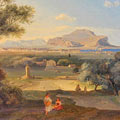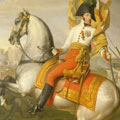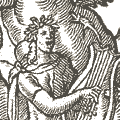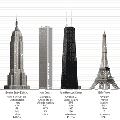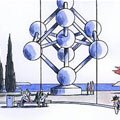onlangs kocht ik twee boeken over toegepaste kunst in de jaren zestig
en ontdekte de ontwerpen van Jesse Tait voor Midwinter Pottery
en ontdekte de ontwerpen van Jesse Tait voor Midwinter Pottery
 Decorative Arts 1960s
Decorative Arts 1960slooks at the birth of pop in a decade of unprecedented social, sexual, and political change. All the restless energies bubbling throughout the world during the 1960s made their way into the design style of the decade. Liberation was in the air, men were rushing to the moon, and the sky was the limit as far as visual creativity was concerned. The concept of lifestyle really came into its own, and although the early years of the decade still saw a rivalry between the well-crafted object and industrial manufacture, by its end both ethnic and pop iconography had gained equal foothold in the aesthetic. Light was also predominant in shaping interiors. Freedom of choice and personal expression were the buzzwords for the young consumer, and so the likes of Pasmore, Panton, Safdie, Sottsass, Paolozzi, and Lomazzi did what they could to oblige.
Paperback | 576 Pagina’s | Taschen | Taschen 25 anniversary ed
ISBN10: 3822850411 | ISBN13: 9783822850411
Bron: bol.com

Judith Miller, Die Sixties
Midwinter Pottery en Jesse Tait
The Midwinter Pottery, established in 1910, came to the forefront of British design during the early 1950s when the company launched an outstanding range of contemporary tablewares to a British public desperate for something new, colourful and pleasing to the eye. As soon as restrictions on the sale of brand new goods was lifted in the UK, Midwinter captured the market with their audacious and abstract patterns that suited the younger generation and reflected the modern interior.
This significant change in design strategy was implemented by Roy Midwinter. He had previously experienced some hostility from North American buyers towards the floral patterns that the company typically produced. The US wanted something new and advised Roy Midwinter to visit the West Coast of America to look at the latest tablewares by American designers such as Eva Zeisel and Russell Wright. Having done this, he decided that, once restrictions were lifted, Midwinter should produce a similar version for both the export trade and the British market.
The Midwinter Pottery, established in 1910, came to the forefront of British design during the early 1950s when the company launched an outstanding range of contemporary tablewares to a British public desperate for something new, colourful and pleasing to the eye. As soon as restrictions on the sale of brand new goods was lifted in the UK, Midwinter captured the market with their audacious and abstract patterns that suited the younger generation and reflected the modern interior.
This significant change in design strategy was implemented by Roy Midwinter. He had previously experienced some hostility from North American buyers towards the floral patterns that the company typically produced. The US wanted something new and advised Roy Midwinter to visit the West Coast of America to look at the latest tablewares by American designers such as Eva Zeisel and Russell Wright. Having done this, he decided that, once restrictions were lifted, Midwinter should produce a similar version for both the export trade and the British market.
Steven Jenkins, Midwinter Pottery
A Revolution in British Tableware
A Revolution in British Tableware
The first range, Stylecraft, launched in 1953, was decorated with many hand-painted and printed patterns. Stylecraft was a complete break away from the heavy Art Deco shapes. The majority of the patterns were created by Jessie Tait, who had joined the company during the late 1940s. Her patterns included „Fiesta„, „Ming Tree„ and „Primavera„ . One of the most popular Stylecraft patterns was „Riviera„ by Hugh Casson – future President of the Royal Academy – based on sketches that he had made in France. The „Riviera„ pattern and the subsequent version called „Cannes„, on the „Fashion„ shape, are highly sought after by collectors. Initially the Stylecraft range was ridiculed by other pottery manufacturers, whose main products were more traditional, but when sales proved outstanding competitors began to copy the Midwinter look.
According to Roy Midwinter, the reason for the success of the company was that it was fashion-led, creating the need to maintain market share by introducing new shapes and patterns. In 1955 the „Fashion„ shape was introduced, decorated with outstanding patterns such as Flower Mist and Festival, designed by Jessie Tait. One of the most outstanding Fashion patterns was „Zambesi„, which proved very popular and was copied by several manufacturers. During the latter part of the „fifties Jessie Tait created the audacious pattern called the „Gay Gobbler„, quite a rarity and much sought after today. Several patterns designed by the young designer and future tycoon Terence Conran were produced on the Fashion shape, including „Plant Life„, „Chequers„, „Nature Study„ and „Salad Ware„. Some of the most eagerly sought after items originate from this period. Fortunately for collectors, Conran’s name was included on the company backstamp!
With such an impact on the market and increased orders from all over the world, Roy Midwinter turned to the development of a new practical shape that could take printed decoration, as hand-painted decoration was proving too costly. The new „Fine„ shape was launched in 1962. Jessie Tait produced many of the important designs such as „Spanish Garden„, „Mexican„ and „Sienna„. At the same time a number of successful patterns were developed by Eve Midwinter, which included „Roselle„, „Bella Vista„ and „Tango„. A number of freelance designs were also produced and these include „Focus„ by Barbara Brown and „Eden„ by Nigel Wilde.
Bron: www.50connect.co.uk
According to Roy Midwinter, the reason for the success of the company was that it was fashion-led, creating the need to maintain market share by introducing new shapes and patterns. In 1955 the „Fashion„ shape was introduced, decorated with outstanding patterns such as Flower Mist and Festival, designed by Jessie Tait. One of the most outstanding Fashion patterns was „Zambesi„, which proved very popular and was copied by several manufacturers. During the latter part of the „fifties Jessie Tait created the audacious pattern called the „Gay Gobbler„, quite a rarity and much sought after today. Several patterns designed by the young designer and future tycoon Terence Conran were produced on the Fashion shape, including „Plant Life„, „Chequers„, „Nature Study„ and „Salad Ware„. Some of the most eagerly sought after items originate from this period. Fortunately for collectors, Conran’s name was included on the company backstamp!
With such an impact on the market and increased orders from all over the world, Roy Midwinter turned to the development of a new practical shape that could take printed decoration, as hand-painted decoration was proving too costly. The new „Fine„ shape was launched in 1962. Jessie Tait produced many of the important designs such as „Spanish Garden„, „Mexican„ and „Sienna„. At the same time a number of successful patterns were developed by Eve Midwinter, which included „Roselle„, „Bella Vista„ and „Tango„. A number of freelance designs were also produced and these include „Focus„ by Barbara Brown and „Eden„ by Nigel Wilde.
Bron: www.50connect.co.uk






